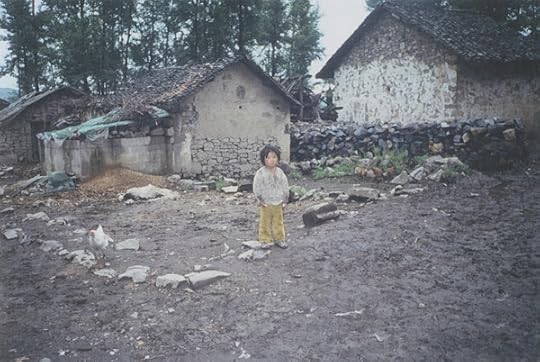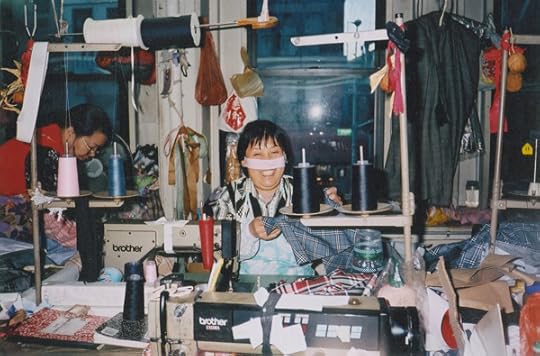Annette LeBox's Blog, page 5
January 3, 2012
Circle Of Cranes
"Write what you know" is good advice to writers, but sometimes "write what fascinates you" makes a more interesting, though longer journey.
Circle of Cranes was inspired by real life events. A series of migrant ships were intercepted off the coast of the Queen Charlotte Islands in British Columbia in the summer of 1999. The migrant ships were headed to New York City's Chinatown where the girls would work in sweatshops stitching clothes and the boys in restaurants. Children as young as seven were on board, some of them without their families. Through a mutual friend, I was able to interview an immigration officer who had boarded one of these ships and described the horrific conditions in the hold. The officer vetted my manuscript to ensure accuracy.
China
In 2000, I travelled to Cao Hai, an impoverished village in the mountains of Guizhou province, to research my novel. Cao Hai is known for the flock of black-necked cranes that winter on the lake, so it seemed an apt birthplace for my main character, Suyin, who belongs to an ancient Crane Sisterhood. Suyin also belongs to the ethnic Miao minority people. Miao women define themselves by the skill of their embroidery.
As I couldn't speak the language, I carried a Chinese-English dictionary and a set of small flashcards with place names in English and Mandarin. Despite the language barrier, the people of rural China went out of their way to help me. I found that the poorest families were the most generous.
In Weining, I met an English-speaking cadre, Ming Jun, who took me to visit Cao Hai Village and acted as my interpreter. The children in Cao Hai had no shoes or books or toys. There was no electricity in the village at that time. Most of the girls couldn't afford to go to school. If the family managed to pay the yearly tuition fee, a son, not a daughter would be sent. The lack of education for girls became one of the themes of my novel.
The International Crane Foundation supports a program called One Helps One in which a sponsor can pay $20. U.S. to pay a girl's tuition fee for a year. There are no administration fees. For more information, contact fengshan@savingcranes.org
To find out more about cranes and their habitat, log onto the International Crane Foundation at www.savingcranes.org.
When I left Cao Hai, Ming Jun arranged for his sister, Ming Xia (or Rose, her English name) to act as my interpreter and in exchange, I would help Rose with her English.

Rose and I at the Luipangshui Train Station the first day we met.
Rose and I had many adventures together. We travelled to the mountain villages near Kaeli while I researched the Miao minority people and their embroidery techniques. To listen to a Podcast of my adventures with Rose called my Chinese Daughter, log onto CBC's Living Outloud, Mothers and Daughters Part 2.
Note: Part 2 of this episode is a story of a mother and daughter who travel to Cambodia to find out what happened to a relative who disappeared during the murderous rule of Pol Pot. The second story is My Chinese Daughter.
The Miao stitch their history on their clothing. In the photo, the young girl is dressed in her festival clothes. Note her lovely silver crown. Suyin, the heroine of Circle of Cranes, belongs to the Miao people in China.
Chinatown, New York

Sweatshop in New York City
An expert in illegal Chinese labour in New York City pointed out the locations of several sweatshops in Chinatown and I managed to talk my way inside one of the shops on the upper floor of a tenement on East Broadway. This shop became the setting in which Suyin, the main character of my novel ,works for pennies as a thread cutter. As the garment workers I met couldn't speak English, I communicated with them by using hand gestures and by drawing pictures. Many garment workers wear masks to protect them from the chemicals clinging to the fibres of the fabric they're stitching. The second shop I entered was unlocked, so I walked inside and began snapping photographs. This angered the factory boss who chased me downstairs and into the street.
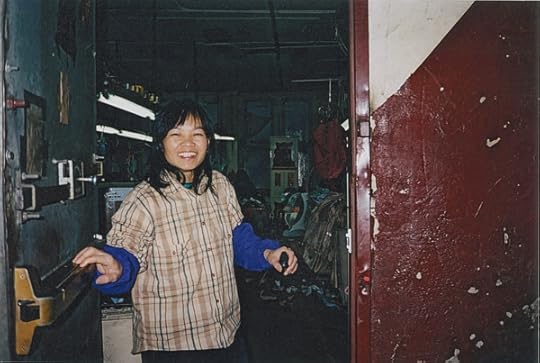
Greeted at the door of the sweatshop
Salmon Creek
I was inspired to write Salmon Creek after I witnessed the endangered wild coho return home to their spawning grounds in Codd Wetland in Pitt Meadows, BC. Codd Wetland harbours 99 species of plants and animals. It is also nesting site of a pair of Greater Sandhill cranes. When the landowner threatened to dig up the wetland for industrial cranberries, the Pitt Polder Preservation Society in partnership with the Land Conservancy of BC campaigned for an additional three years and seven months to save the wetland. In 2004, the Pitt Polder Preservation Society celebrated Codd Wetland's conservation as a regional park.

The Codd Wetland
Bruce Clark of the Department of Fisheries and Oceans, Canada, trapped and released baby coho as proof that Codd Wetland was important salmon habitat
book image courtesy Groundwood Press
Wild Bog Tea
I wrote Wild Bog Tea as a plea to preserve Blaney Bog. This rare and hidden wetland, located in Maple Ridge, British Columbia, was slated for an industrial cranberry operation. Members of the Pitt Polder Preservation Society and myself launched a grassroots campaign to preserve the bog. After three years of raising awareness, letter-writing, fundraising and lobbying various levels of government, our efforts finally paid off. Blaney Bog was set aside as regional park.
Members of the Pitt Polder Preservation Society and myself launched a grassroots campaign to preserve the bog. After three years of raising awareness, letter-writing, fundraising and lobbying various levels of government, our efforts finally paid off and the bog was set aside as regional park.
I took Harvey Chan, illustrator of Wild Bog Tea, into the bog one rainy November day. We got soaked and for awhile we were lost. Had to bushwhack our way out, a new experience for Harvey.
Miracle at Willowcreek
Miracle of Willowcreek is based on my experiences fighting another development proposal on the Pitt Polder. In the novel, the main character, Tess, and her friends take a courageous stand against developers in order to save a small flock of Sandhill cranes. When Tess and her friends encounter a wonderful bird woman named Clara, adventure and a struggle to protect the cranes quickly coincide.
In 1996, the Pitt Polder Preservation Society was formed in response to a proposal by Swan-e-set Bay Resort to change a municipal bylaw that would have set a dangerous precedent allowing for the rapid urbanization of a sensitive wetland area.
After a lengthy battle, the Polder Society won a critical legal decision that stopped the development. The Swan-e-set development proposal had divided the community, but it had also forged lasting friendships.
For a detailed history of the Swan-e-set development versus the Pitt Polder Preservation Society, log onto Pitt Polder Preservation Society.
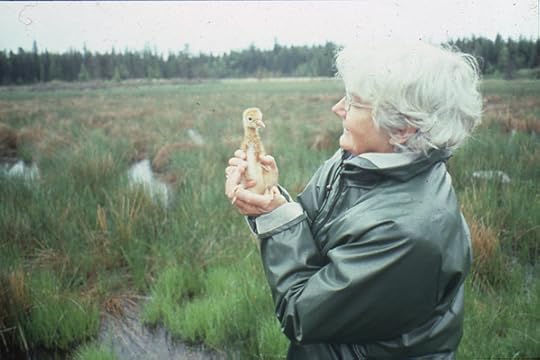
Wilma Robinson, the real life bird woman, holds a crane chick.
The Princess Who Danced With Cranes
When Swan-set Bay Resort proposed to build a golf course in the Pitt Polder, I wrote a fairytale about the detrimental effects of golf courses on wetlands. The Pitt Polder is a lowland area in Pitt Meadows, British Columbia, about 46 kilometres east of Vancouver. Located along the Pacific Flyway, the polder is home to 200 species of birds, including a flock of fifteen Greater Sandhill cranes. The golf course was built, despite the concerns of naturalists who worried that loss of habitat could mean the destruction of the tiny flock.
In the fairytale, the princess and the villagers dance with the cranes until they become entranced with the game of 'gullywhupper' (ie golf). When the villagers drain the wetland to expand the course, the results are devastating. While I couldn't quite bring myself to write a 'happily ever after' ending to the story, I did give the princess hope for the future.
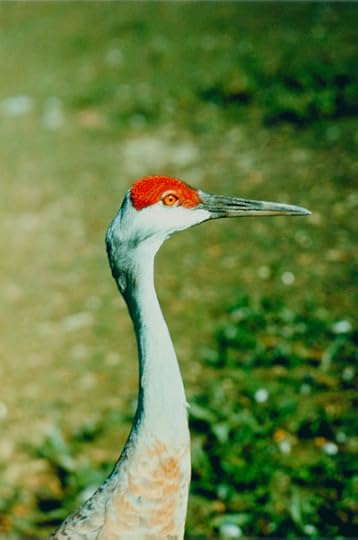
Sandhill Crane
As the story took place long ago, I changed the game of golf to gullwhupper because I liked the sound of the word and it seemed whimsical. While I couldn't quite bring myself to write a 'happily ever after' ending, I did give the princess hope for the future.

